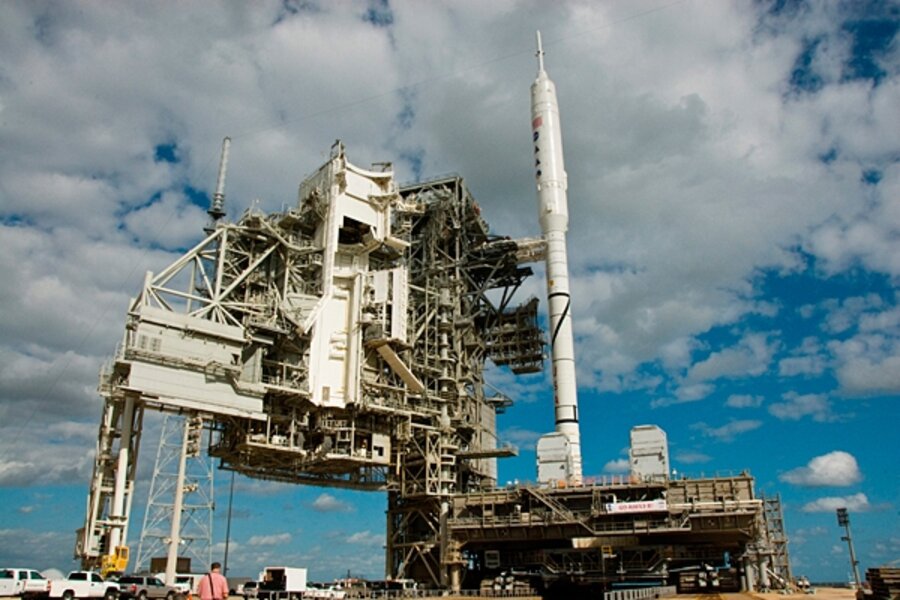Augustine report: tough choices ahead on human spaceflight
Loading...
President Obama and Congress face a stark choice on the future of NASA's human spaceflight program: Either scale back ambitious goals first set out in 2005 or pony up more money to match the ambitions.
That's the implication of options set out in the final report from the Review of US Human Spaceflight Plans committee, unveiled Thursday afternoon.
NASA's current path, as set by former President George W. Bush, aims to return astronauts to the moon. The political fight will likely be over whether to continue on that path or to shift to a different lineup of rockets and destinations.
"The human spaceflight program that the United States is currently pursuing is ... on an unsustainable trajectory," said panel chairman Normal Augustine in summarizing the 157-page report Thursday afternoon at a press briefing in Washington.
The latest document's key points appeared in a summary presented to the White House and NASA Sept. 8. After deliberating over the summer, the 10 members – ranging from former astronauts and current and former aerospace executives to academics – settled on three broad paths the US could follow.
One option: building a rocket to nowhere?
One broad class of options involves sticking close to the original program and funding levels. But that would result in NASA building rockets to nowhere, the panel projected. NASA's replacements for the space shuttle are the Ares 1 and its crew capsule, and a more powerful Ares 5 rocket. Ares 1 is unlikely to be ready before 2017, according to the panel. If NASA shuts down the space station in 2015, Ares 1 would have no destination. If NASA shuts down the station in 2020, Ares 1 would have nowhere to launch to after 2020. Either way, Ares 1 would be a rocket with no clear destination. And NASA wouldn't have the money to fill out the rest of its lunar agenda.
Second option: more money
The other two broad classes of options assume more money. They envision either going to the moon first or aiming at true "firsts" – sending crews to visit an asteroid or to orbit Mars, for instance. But for these missions, Ares 1 falls by the wayside. Instead, NASA would build a version of Ares 5 and have it do double duty, acting as a taxi while also fulfilling its original purpose as a cargo ship capable of lifting heavy payloads into space.
Key role for commercial rocket companies?
Alternatively, taxi duties could be handed off to commercial rocket companies – either to long-established companies or to a new breed of rocketeers working on launch vehicles. In principle, the agency could even turn over to beefed-up commercial rockets the heavy-cargo duties assigned to the Ares 5, the panel suggested.
But this has raised red flags among some influential lawmakers. During congressional hearings on the panel's options last month, Rep. Gabrielle Giffords (D) of Arizona was skeptical that a new generation of commercial-rocket start-ups will be able to pick up taxi duties.
In a statement Thursday, Representative Giffords repeated her objection to having "our astronauts held hostage of purchases of seats of nonexistent commercial providers."
She noted that the Augustine panel had no complaints about how NASA's new Constellation program was being run. It found no flaws in the program's initial budget, set out in 2005 at a time when outlying budget years held no inkling of a global financial collapse. And it was confident that the agency could overcome technical glitches that are inherent to any new rocket design.
"Now that both internal and eternal independent reviews have confirmed that the Constellation program is being well executed, we know what needs to be done," said Giffords, who chairs the House Science and Technology Committee's Space and Aeronautics Subcommittee.
Third option: the Apollo creed
But history suggests a potential third path, says Howard McCurdy, a space-policy specialist at American University in Washington.
When the US was desperate to put a human on the moon before the end of the 1960s, it got creative. Previously, NASA's approach to testing rockets was methodical – reflective of the Teutonic tendencies of the German scientists who created it. They tested one stage of a rocket at a time. During the Apollo years, however, NASA tested all three stages of the Saturn V rocket in a single test flight, shrinking the amount of time needed to get the Apollo program off the ground.
The first test flight for the Ares 1-X is scheduled for next week – and NASA is reverting to the one-stage-at-a-time approach.
Apollo's same flexibility can be applied to a different challenge today, Mr. McCurdy says: "My question is: What's the equivalent reform needed to hold the Constellation program to its existing budget?"
He adds: "Maybe the White House comes back and says: We want you to continue with the Vision for Space Exploration, and we want you to be creative in finding ways to do it."
----
What's the buzz on the Orionid meteor shower?
NASA got it about right: 60 meteors per hour.
-----
Follow us on Twitter.





